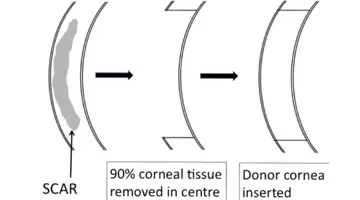Why would I need a corneal transplant?
The cornea is a window of transparent tissue at the front of the eyeball. It allows light to pass into the eye and provides focus so that images can be seen. Various diseases or injury can make the cornea either cloudy or out of shape. This prevents the normal passage of light and affects vision.
The cornea has three layers (thin outer and inner layers and a thick middle layer). In some diseases, only the middle layer or part of the middle layer is affected.
DALK is a modern technique whereby the outer two layers of the cornea are removed and replaced with the outer two layers from a donor cornea to give a partial-thickness transplant.

Benefits of deep anterior lamellar keratoplasty (DALK):
Improved vision
Approximately 75% of transplant recipients for this surgery have good enough vision to drive legally, although they usually need glasses or contact lenses or sometimes further surgery for best results.
It can take up to 18 months until the full improvement in vision is seen.
Risks of deep anterior lamellar keratoplasty (DALK)
Rare but serious complications
- Sight-threatening infection (1 in 1,000)
- Severe haemorrhage causing loss of vision
- Retinal detachment
- Severe inflammation or other rare causes of vision loss.
Corneal transplant rejection
A corneal transplant may be rejected by your immune system. This happens in less than 10% of DALK recipients in the first two years after transplantation and can cause graft failure. However, it can often be reversed if anti-rejection medication is started promptly.
Graft failure
When a graft fails, the cornea becomes cloudy again and vision becomes blurred.
Glaucoma
Glaucoma can usually be controlled by eye drops, but occasionally requires surgery and may harm your sight.
Cataract
Cataract can be removed surgically.
Conversion to penetrating keratoplasty
Occasionally, it is not possible to perform a partial thickness transplant and a full-thickness transplant must be performed instead (penetrating keratoplasty).
Possible advantages of DALK over full-thickness graft
- Lower risk of intraocular (inside the eye) problems such as serious infection or bleeding
- Lower risk of graft rejection
- The corneal wound after DALK is stronger than that after a full-thickness graft (PK). This means that stitches can be removed sooner.
Possible disadvantages of DALK over full-thickness graft
DALK recipients have a slightly lower chance of achieving 6/6 (excellent) vision than recipients of full-thickness grafts.
About the operation
The operation
The operation is performed under general or local anaesthetic, and takes about one hour. A central partial thickness 8mm button of your cornea is removed and a similar-sized button of the donor cornea is stitched in with tiny stitches (see front cover). These cannot be felt or seen. The abnormal cornea, which is removed, is sent to our pathology laboratory for examination under a microscope.
After the operation
You will usually be examined by the surgical team after the surgery and can generally go home the same day. You will be seen again within one week in the outpatient clinic and regularly thereafter (approximately six visits in the first year). We generally recommend that you take two weeks off work but please discuss your individual circumstances with your doctor. You will need to use anti-rejection eye drops for at least six months and indefinitely in some cases. Individual stitches may be removed from three months after the operation, but complete stitch removal is not performed until at least one year after the procedure.
What if my transplant fails?
A failed transplant can be replaced in a procedure known as a re-graft. However, the risk of further rejection and failure increases each time for second and subsequent re-grafts.
Corneal transplant rejection needs urgent treatment, as this can lead to failure of the transplant and loss of vision.
Symptoms of rejection are:
- Red eye
- Sensitivity to light
- Visual loss
- Pain
If you experience any of these symptoms, you should come immediately to our 24-hour emergency department in our hospital in City Road. If in doubt, call 020 7253 3411 and ask to speak with the doctor on duty in the emergency department.
Consenting for information sharing
To comply with the law and to ensure high quality transplant material, we are required to share your information with the NHS Blood and Transplant Special Health Authority (NHSBT), who supply donor corneas. However, we require your consent to share this information. If you do not give consent for your information to be shared with or held by the NHSBT, this may affect availability of donor tissue for the transplant or create problems with contacting you should any issues be identified later on with the tissue you received.
Review date: February 2020